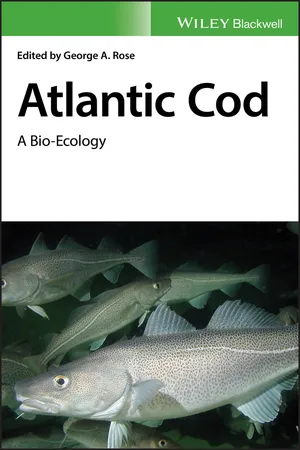
- English
- ePUB (mobile friendly)
- Available on iOS & Android
About this book
A comprehensive handbook, covering all aspects of the Atlantic cod including the biology, ecology, life histories, behaviour, commercial exploitation and conservation
Not only is Atlantic cod one of the most valuable food fish in the world's oceans, it is an important component of North Atlantic ecosystems and has been subject to much research into its biology, ecology and exploitation. After hundreds of years of exploitation, overfishing in the last half of the 20 th Century caused many stocks to collapse, most famously the Northern cod stock off Newfoundland and Labrador, Canada. Since then, most cod stocks have been better researched and managed, but remain in a variety of states, from fully recovered to continued decline. This book, written by world experts, describes that research and management, and the importance of cod and its fisheries on North Atlantic cultures and economies, with impacts well beyond the range of the species.
Atlantic Cod: Bio-Ecology of the Fish offers insightful chapter coverage of cod nomenclature, taxonomy, phylogeny and morphology; physiology and ecophysiology; reproduction and spawning behavior; early life history and pre-recruitment processes; migrations, movements and stock identity; feeding, growth and energetics; the place of cod in the ecosystem; the exploitation of cod through history and present day commercial fisheries and precautionary management for sustainable fisheries; impacts of climate change on cod biology and ecology; and the future of the species and its fisheries.
- Discusses the major commercial importance of Atlantic cod through history
- Provides a comprehensive treatment of the bio-ecology of the most researched and highly exploited fully marine species
- Examines how the decline (and recovery) of cod stocks is of great political and scientific interest
- An essential purchase for marine fisheries scientists
Atlantic Cod: Bio-Ecology of the Fish is a vital book for all fisheries scientists, managers and fish biologists.
Frequently asked questions
- Essential is ideal for learners and professionals who enjoy exploring a wide range of subjects. Access the Essential Library with 800,000+ trusted titles and best-sellers across business, personal growth, and the humanities. Includes unlimited reading time and Standard Read Aloud voice.
- Complete: Perfect for advanced learners and researchers needing full, unrestricted access. Unlock 1.4M+ books across hundreds of subjects, including academic and specialized titles. The Complete Plan also includes advanced features like Premium Read Aloud and Research Assistant.
Please note we cannot support devices running on iOS 13 and Android 7 or earlier. Learn more about using the app.
Information
1
Atlantic Cod: Origin and Evolution
1.1 Introduction


1.2 Taxonomy and Morphology
1.3 Origin and Evolution
Table of contents
- Cover
- Table of Contents
- Preface
- List of Contributors
- Atlantic Cod: A Bio‐Ecology
- 1 Atlantic Cod: Origin and Evolution
- 2 Ecophysiology
- 3 Reproduction and Spawning
- 4 Early Life History
- 5 Migration
- 6 Feeding, Growth, and Trophic Ecology
- 7 Exploitation: Cod is Fish and Fish is Cod
- 8 Cod and Climate Change
- 9 The Future of Wild Cod and Their Fisheries
- Index
- End User License Agreement